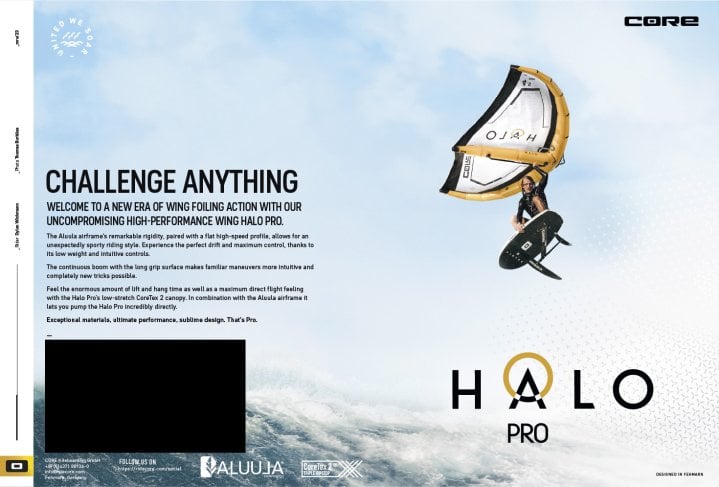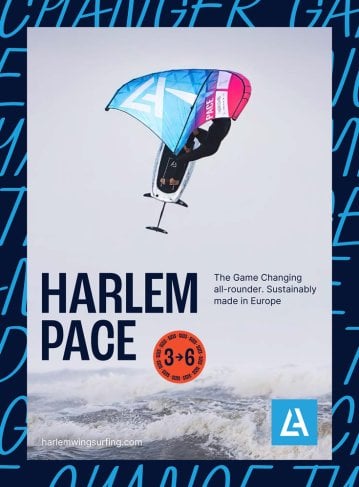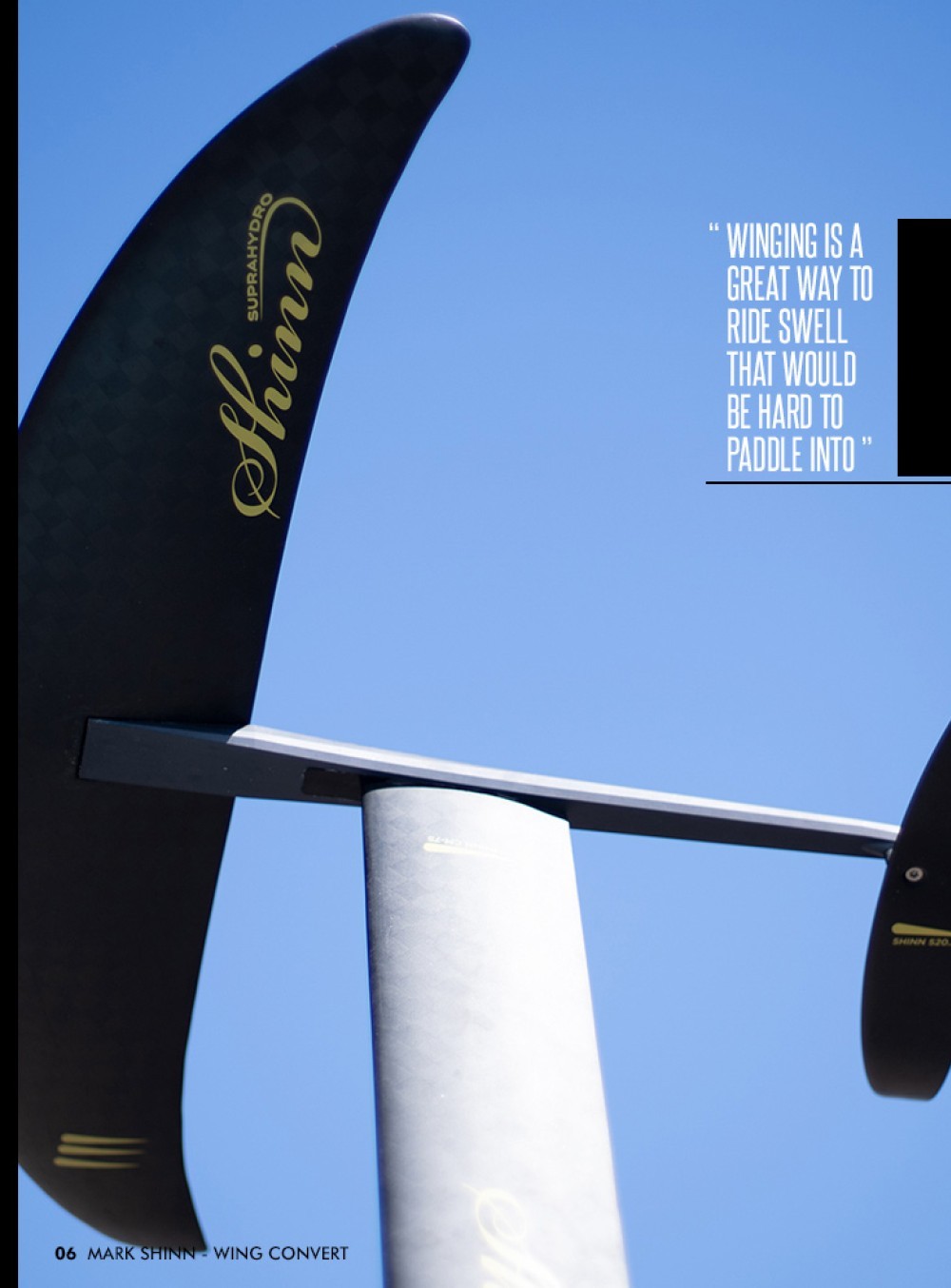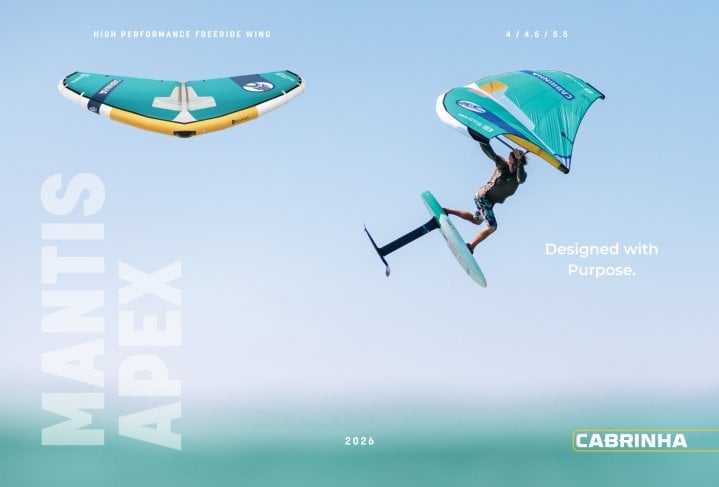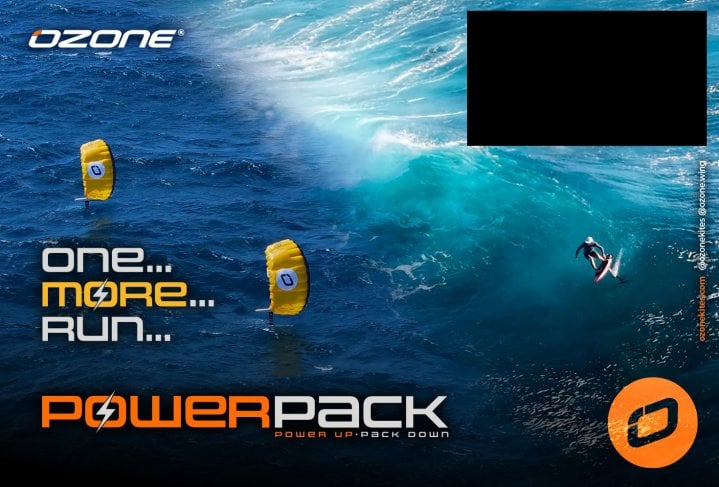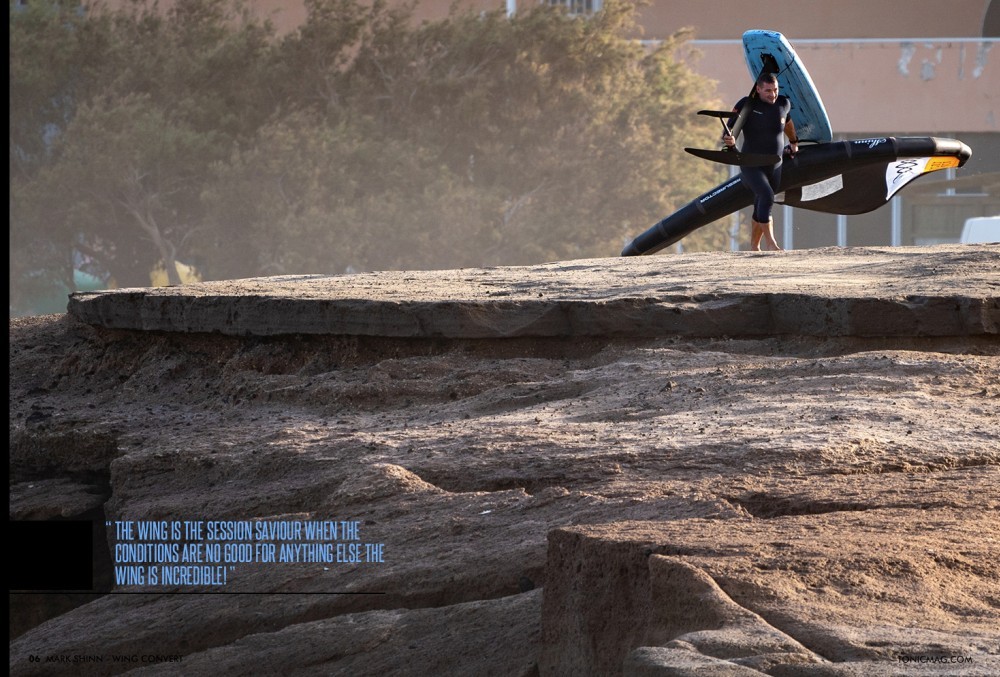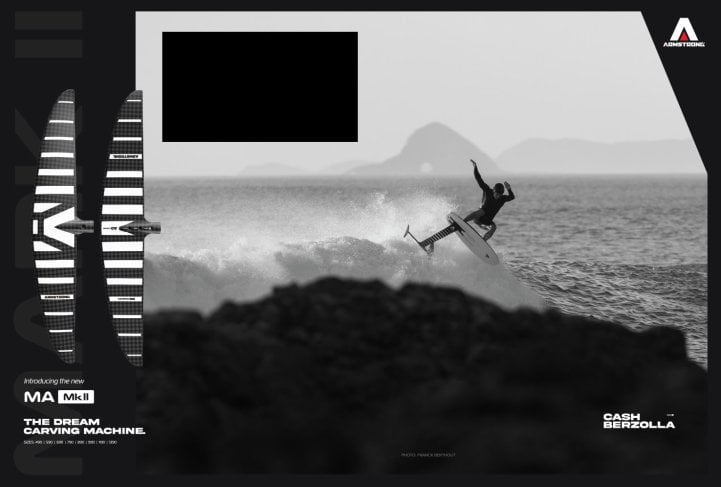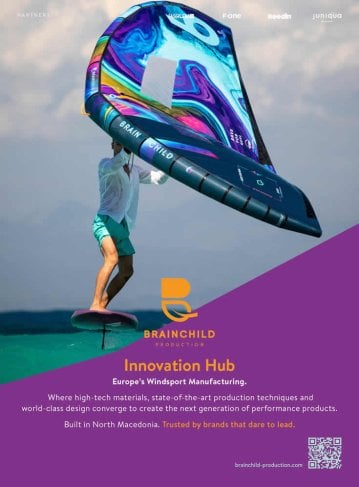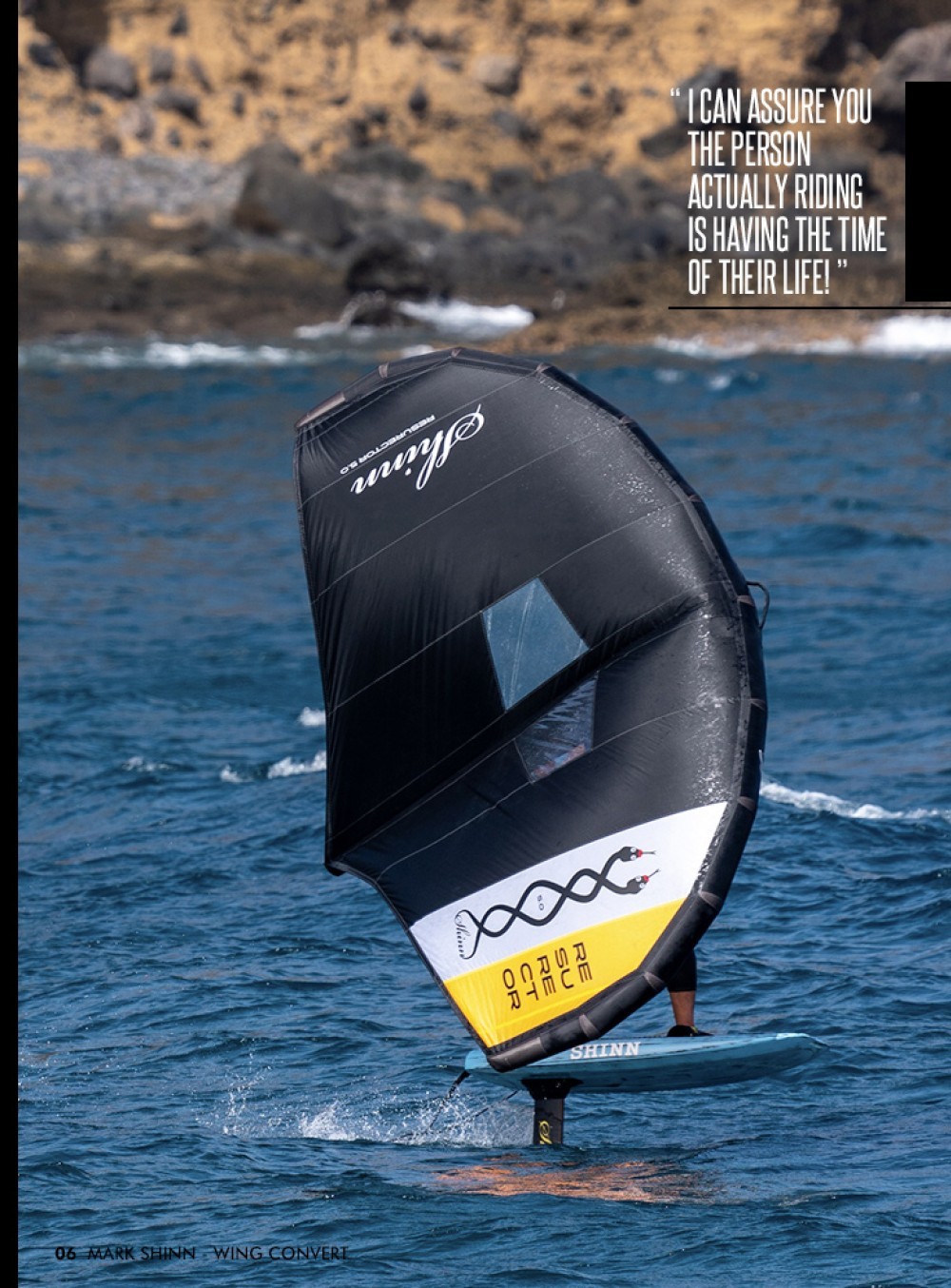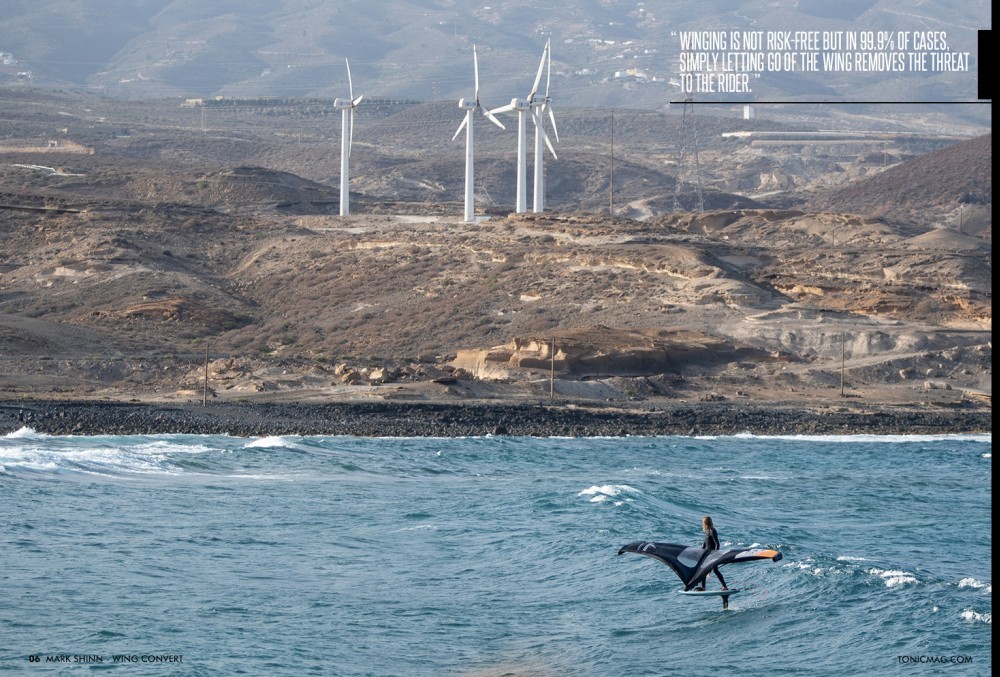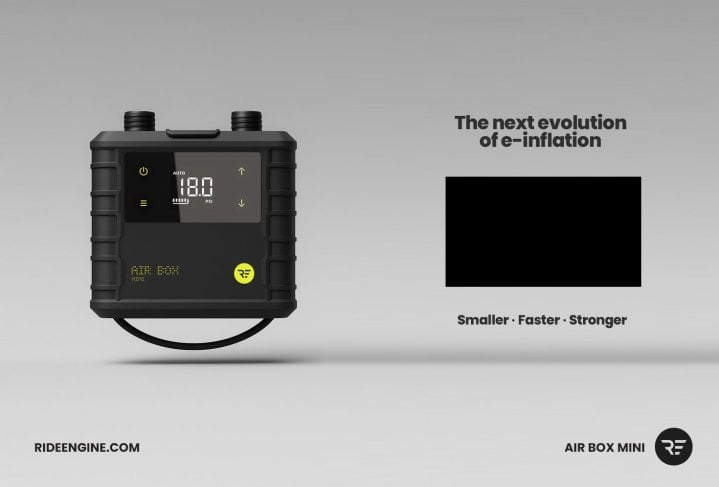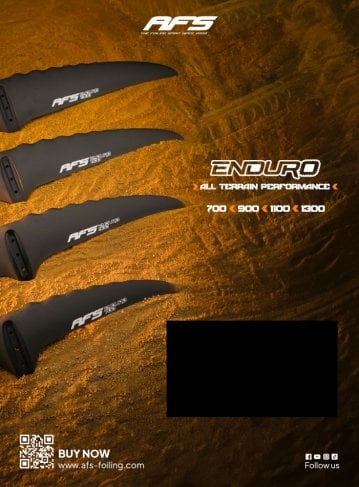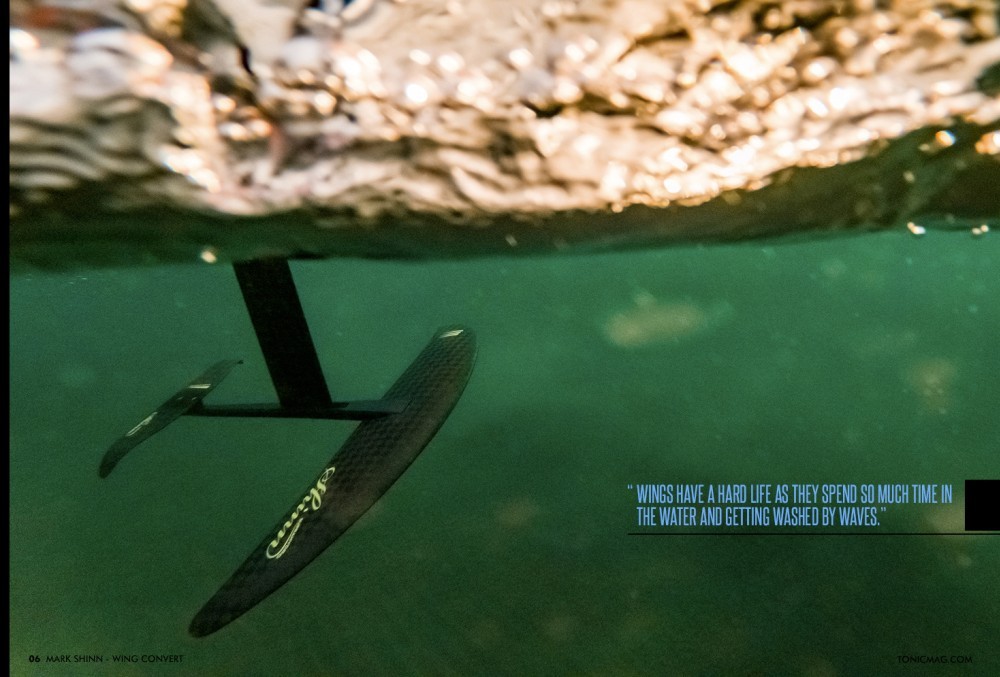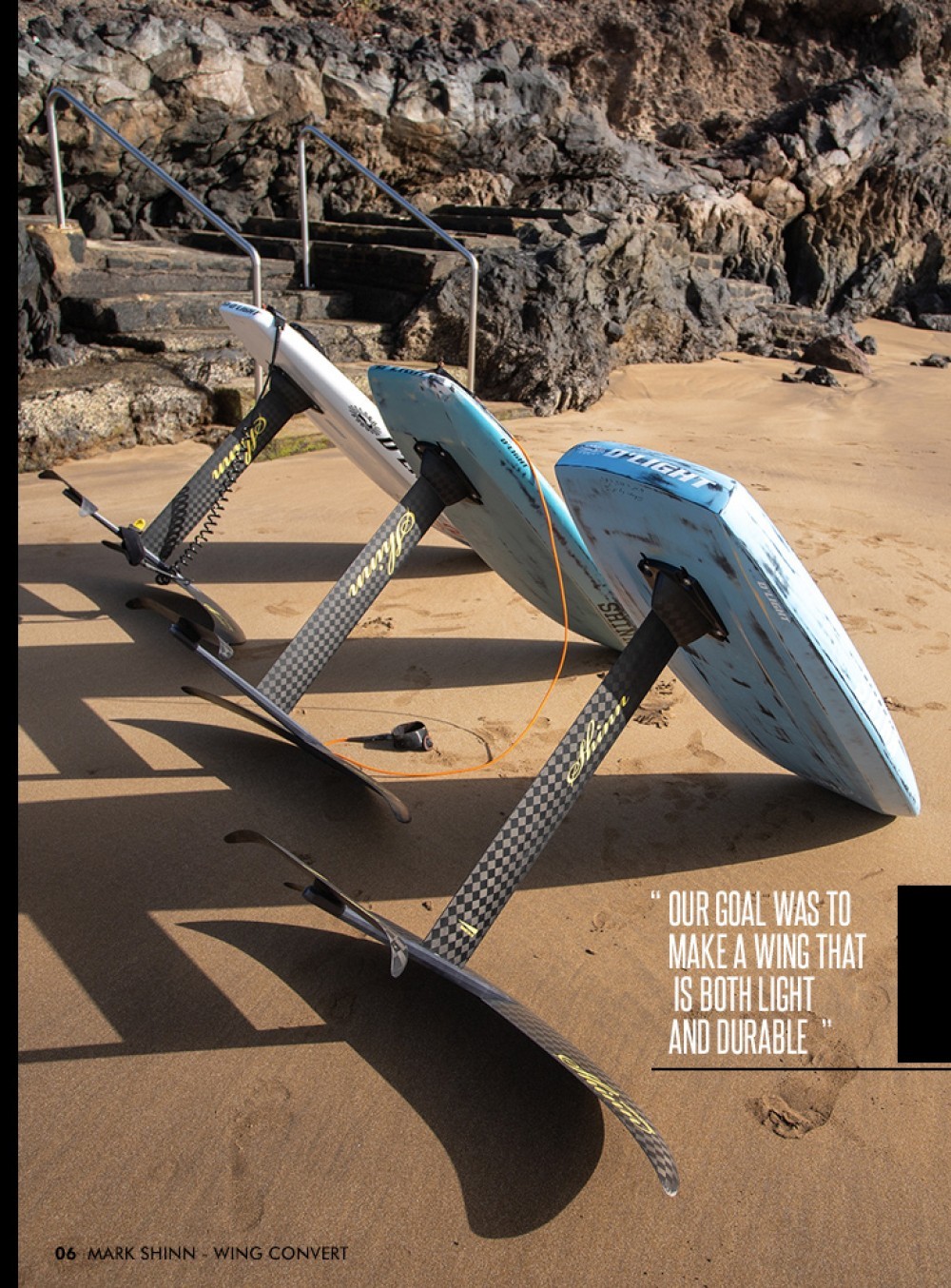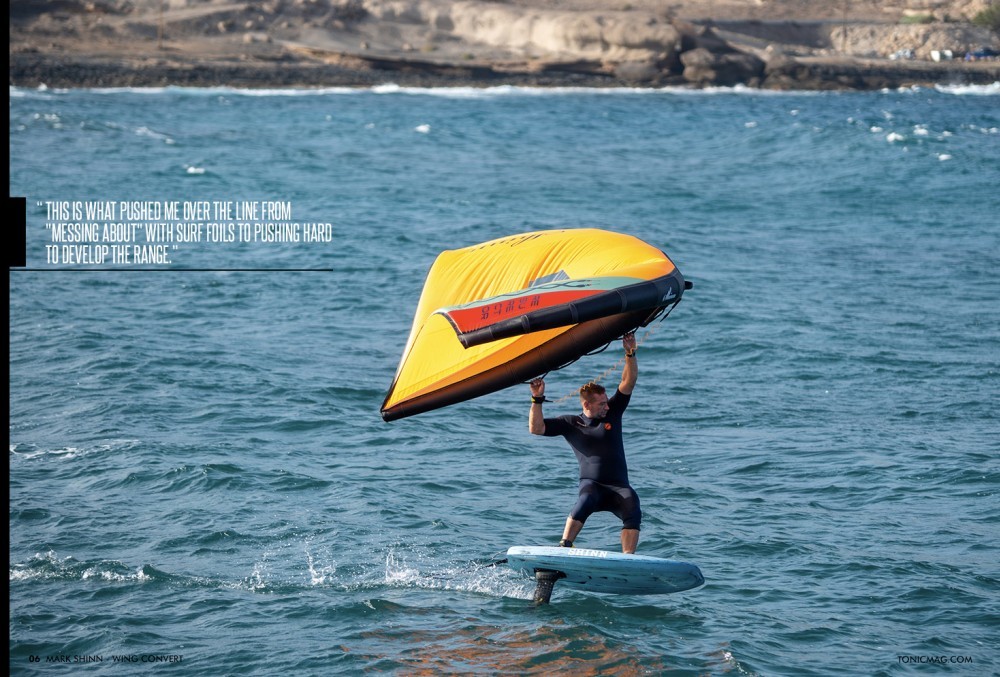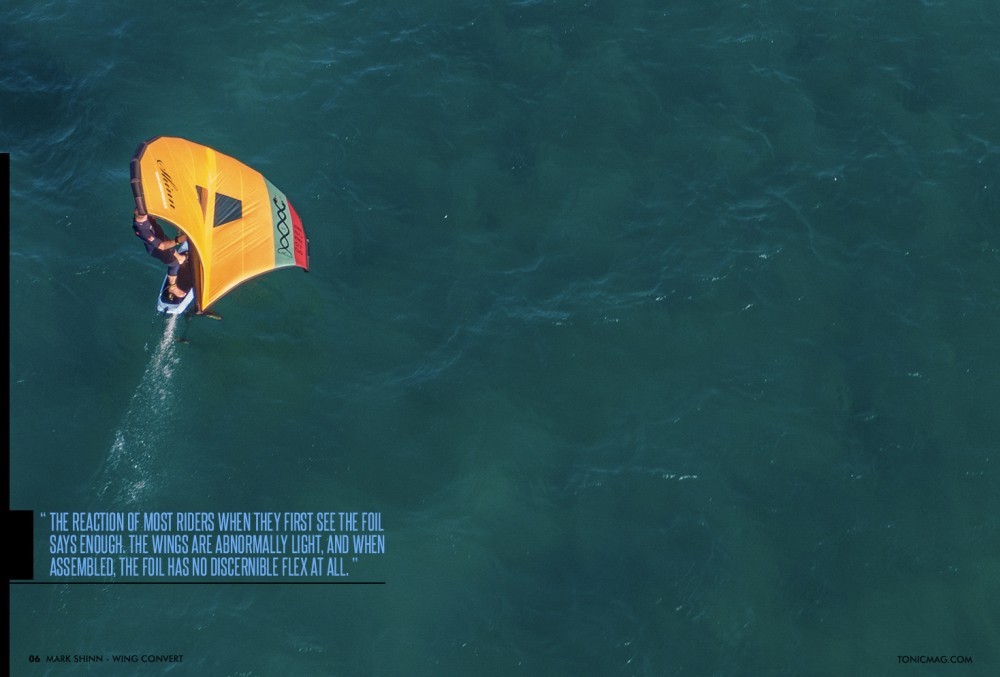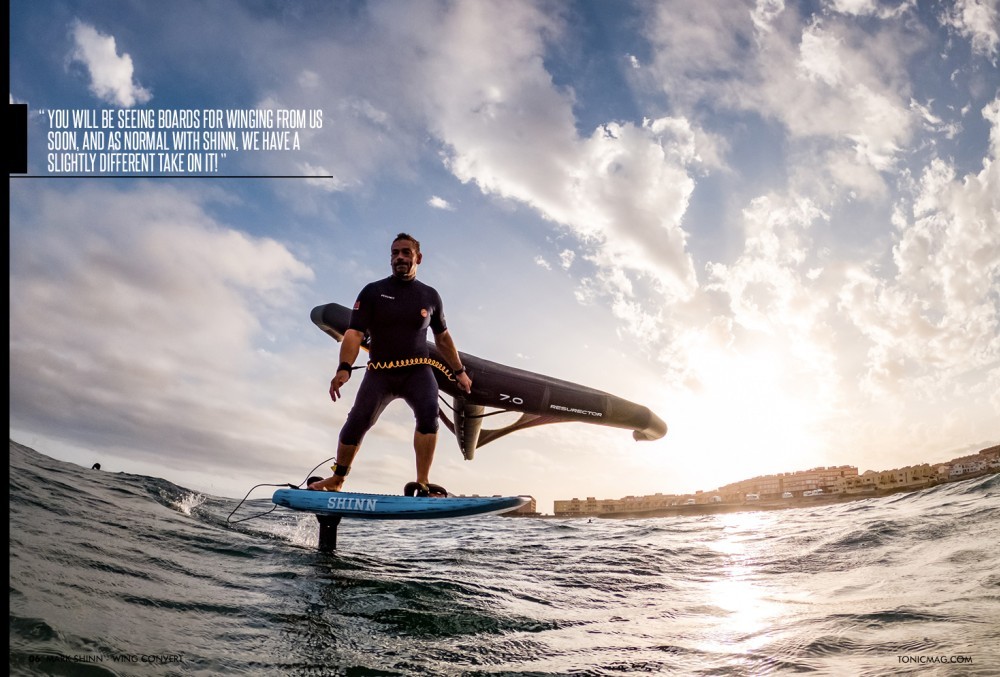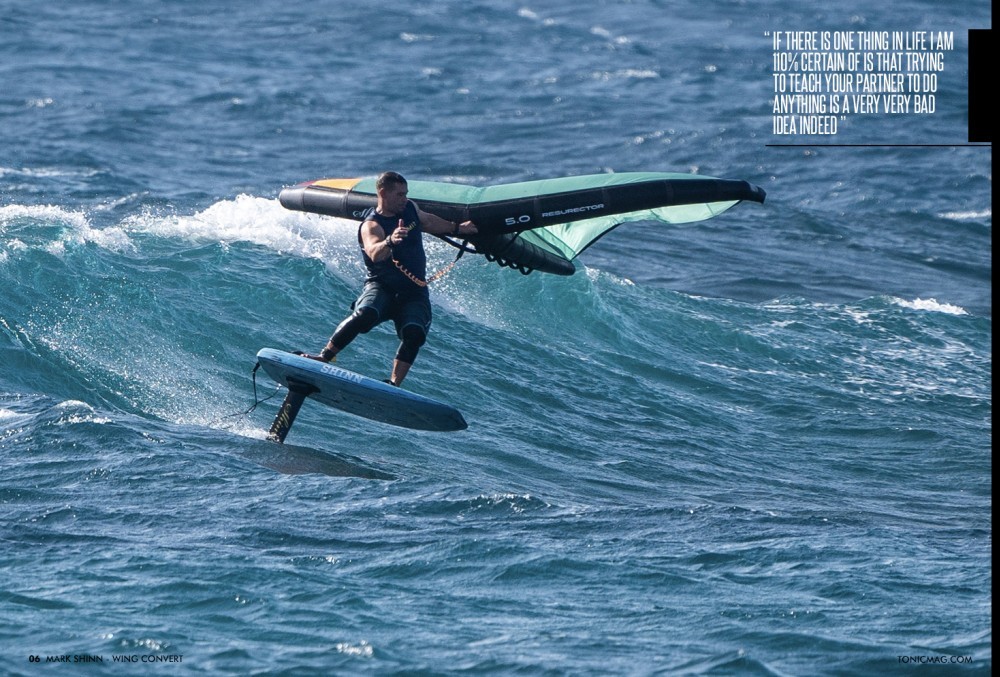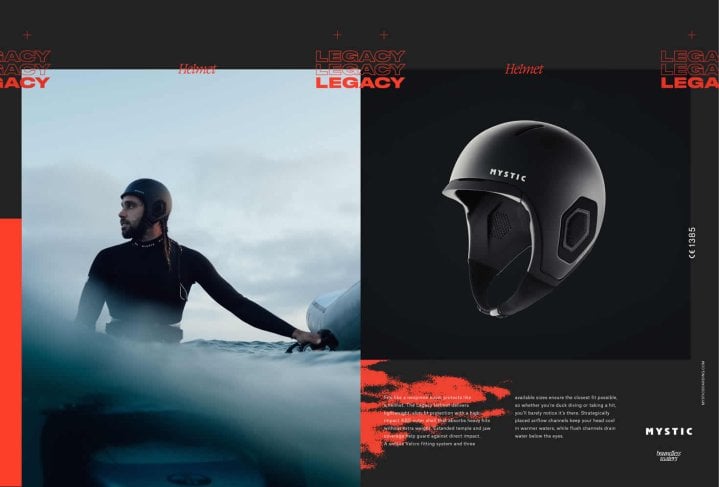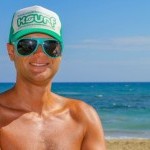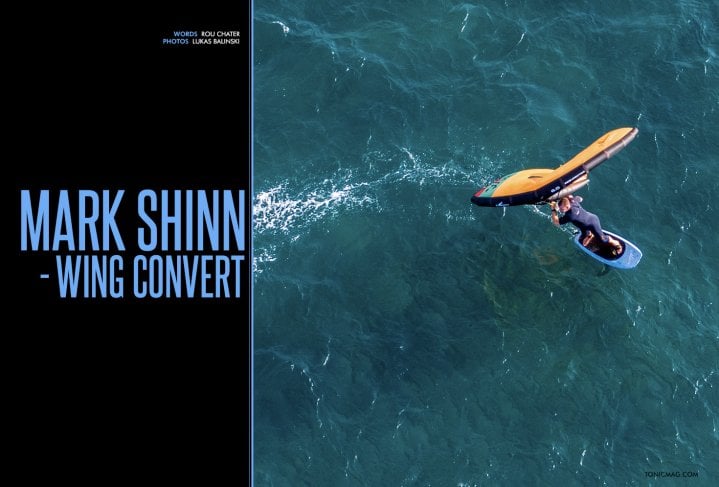
Wing Convert - Mark Shinn
Issue 6 / Sun 8th Nov, 2020
It’s not always love at first sight, Mark Shinn didn’t immediately see the appeal of the wing, but now he is well and truly hooked. Rou Chater chats to Mark about why he is so stoked on wings, and the new products he is launching. Get inspired right here!
Mark Shinn has been involved in the watersports industry for longer than most, an accomplished surfer and windsurfer he rose to fame as the most talented kiteboarder of his time when he won two world championships in the early '00s. Always a keen product developer in recent years he's been working hard on the Shinn brand producing twin tips and foils for kiting. I had a few conversations with Mark about wing surfing in the early days, and he wasn't particularly enamoured. Then something changed...
You were quite vocal in there early days of the sport about how it wasn't for you, what was your argument back then against the wing?
The first time I saw the wing, I was less than enthusiastic. I'm not sure if it was Duotone, Naish or F one that caught my attention first. However, I do remember that all the images I saw were in strong winds and waves, in fact, one of those 3 had an intro video in waves that 90% of the windsurfers and kiters in the world would die to be out in - exceptional conditions.
I love foiling of any kind, and I was never anti winging from a philosophical perspective; however, it looked so much like another high wind sport that I simply wasn't interested in. Like most people I live in a place that is not very windy, strong days are few and far between, and when they come I have kite-wave boards, big air TT's, windsurf gear etc. to play with, all of which simply doesn't get enough time on the water. Adding yet another strong wind sport to the mix seemed pointless and ultimately frustrating.
What happened and why did your view change, was it gradual, or was it a lightbulb moment?
The first sessions I found nothing at all that changed my mind. Wings were pretty much only available in 4m size, my board was not ideal, I had no idea what to do. I persevered because until you have at least some degree of mastery of a sport you shouldn't judge it but no doubt the first days were all about work and nothing to do with fun.
I did have one day in 25 to 30 knots that I could foil comfortably, and I did enjoy it, but it only cemented in my mind that winging was fun (I never doubted it) but not a sport for me and where I live. In October last year, I was in Ireland and had my first tastes of winging in swell, you wouldn't call them waves, just swell bumps really and this re-enforced in my mind what I already thought.
Winging is a great way to ride swell that would be hard to paddle into but what really turned it around was that a Danish guy turned up with a 7m wing and was easily foiling in 8 to 10 knots with little sign he was struggling to ride swell with the big wing. This was the pivotal point for me because the sport suddenly revealed itself as possible in light winds and that is critical…the world excels in light wind and poor swell spots and a sport that makes those conditions fun…that HAS to be a winner!
You practice a lot of watersports, as well as having a passion for cycling too, how does the wing fit into your sessions?
I have a love of waves and surfing. It was my first sport, and though I love all the sports I do, there is something magical about surfing. Now the downside, it is hard to score a good surf day due to conditions, swell and crowds. Unless you're lucky enough to live on a prime spot, surfing can be extremely frustrating.
Winging unlocks the possibilities when no other sport allows you to ride. Surf and SUP foiling already started down this path, but for most of us you still need some kind of a wave to start foiling, and where I live that means water not deep enough to foil in. Sure, you could tow in, but I don't have a ski, I don't have a driver, and I don't like engines!
The wing becomes your own personal ski. I'm mobile enough to go where I want, and when riding swell it doesn't interfere at all. Kites and windsurf sails are great but still limit you to a specific range of directions whereas the wing can be ridden in any direction. Maybe this became a long answer to a short question. The wing is the session saviour when the conditions are no good for anything else the wing is incredible!
What would you say to someone looking at the sport and thinking it isn't for them?
Some sports are visual, you watch it, you have an empathy for it, and you have this burning desire that you HAVE to learn to do it. It's radical, adrenaline-filled - amazing. Some sports are more about the feeling, and winging is absolutely one of those.
You can watch someone winging and think it looks strange or even dull, but I can assure you the person actually riding is having the time of their life! I have met very few riders that tried the wing and didn't continue with it. My advice is, don't judge till you have given it a go and progressed enough to be able to foil.
How popular is it getting back home in Poland?
It's coming, but I would say there are not more than 50 or 60 wingers in Poland right now, but it will come. There is a wide range of windsurfers, surfers and kiters all interested, but most are sitting back to watch how it develops before committing to buying gear. The winter in Poland is harsh, and very few riders continue to practise, so I expect to see a surge in the spring. In fact, Poland has one of the best wing spots I have encountered till now, the combination of an exposed coast and an extended sea wall to shield the harbour creates a playground of chop free swell that you can ride for AGES!!
The sport has seen the Shinn brand move from boards and foils into the inflatable market, why did you decide to make a wing now when you have avoided making kites in the past under the Shinn moniker?
I personally have been involved in kite development first with Naish, and then with Nobile brand. I never had a passion for this side of the sport, the safety issues for kiting have also scared me both through rider safety and company liability. Winging is not risk-free but in 99.9% of cases, simply letting go of the wing removes the threat to the rider. In addition to this, I love to develop gear, when I see a gap or hole in the market for a product or piece of a product that I feel is missing I can't help myself but want to get involved. For one year, I used wings from other brands, but I didn't feel like any of them had it 100% right in either the design overall or the details.
I wanted to create a product that felt complete, in this case, a wing with perfect flight characteristics and without the annoying small detail failures that the wings I was using before had. A lot of the time, I am talking about little details; things like the inability to pack the wing away quickly due to the lack of a dump valve on the strut. Or the storage bag being too small to get the wing into on a wet and windy beach, and not having a wide enough range of handles to be able to hold the wing as you want in all conditions.
What makes your wing different?
That answer lies partly in the question before! I feel like there are 3 areas we worked hard on to make the Resurector stand out. Firstly, the general design, having tested nearly all the wings on the market, we were able to define the important characteristics in a wing.
You need good power and stiffness for starting early and pumping efficiency, also a balanced and stable canopy profile that allows progressive depower of the wing without causing it to nose stall and flip upside down in your hand. Finally, the leading edge curve and angle of attack in the wingtips needs to ensure the wing doesn't flip from a simple tip strike in the water. These are the flying characteristics of the wing.
The second area of focus was on construction and durability, wings have a hard life as they spend so much time in the water and getting washed by waves. Intelligent construction I would call it, areas like the handle attachments get a hammering and need to be extremely robust while other areas are relatively stress-free and weight can be saved here.
It's easy to strip a wing bare and make the lightest wing on the market that looks like a used cotton t-shirt after 3 times on the water, our goal was to make a wing that is both light and durable to ensure it works for years, not weeks.
Finally, the third focus was the small details, features like using twin inflation valves, one in the leading edge and one in the strut. This allows fast deflation of the wing but also more pressure to be applied to the strut to ensure a rigid feeling of the wing without risking structural compromise on the leading edge. You also need a full set of handles, no two riders are the same. I have been frustrated many times using a wing where another rider has decided where I should place my hands, in particular, the transition or intermediate handle is a must for me.
This allows the flying of the wing, with power, in one hand - a fantastic addition for riding weak swell when you sometimes need just a little surge of power to transition to the next steep section. It is also extremely useful for starting on smaller boards as you can generate some power in the wing to stabilise yourself whilst preparing to stand up.
The little details are not the things that strike you in the shop when you decide which wing to buy, but once you are on the beach and on the water they are the things that you appreciate (ever been on a cold, wet and windy beach trying to pack down a wing that you can't get the air out of the strut quickly? It is FRUSTRATING!!!!!
In terms of foils you have a pretty extensive knowledge already and were working on surf and SUP foils before, are the demands different for wings?
I love foils and have greatly enjoyed designing kite foils for the last few years. Since the beginning, I was working on larger surf foils, but the cost of development is high, and I didn't see the market growing too much as surf and sup foiling is HARD. Winging changed all that as I could see a huge demand for foils and this is what pushed me over the line from "messing about" with surf foils to pushing hard to develop the range. It's a complicated subject, most kiters have a foil and use it in all the conditions they will foil in however surf, and wing foilers are changing the front wing of the foil depending on the conditions, this takes the modular approach to a whole new level.
Our Suprahydro foil range consists of 6 front wings (well 5 and one more to come shortly!), 2 stabilisers, 2 fuselages, 5 carbon mast lengths and 4 aluminium mast lengths… there is a possible 300 combinations to make up a Suprahydro foil set! Right now there is a general belief that High Aspect Ration wings deliver more efficiency and glide, but low aspect ratio foils are better for carving.
However, it's not a belief that I follow, and from the start, I set out to develop a foil that delivered superior glide and efficiency but still allowed radical, tight radius turns both in a skate flat turn regard but also a more 'full rail' power type of carve. I really think we have delivered that and I couldn't be happier with the results. Of course, it's not just about profiles and wing outlines, the structure of the foil has to be stiff and rugged too.
You can make the fastest car in the world, but if you don't inflate the tyres it won't be going anywhere at all and flex in a hydrofoil is exactly like driving a car with flat tyres. Using the experience and knowledge from our in house engineering and construction team we've developed probably the lightest and yet stiffest surf foil on the market, it's an easy claim to make but the reaction of most riders when they first see the foil says enough. The wings are abnormally light, and when assembled, the foil has no discernible flex at all.
When will the new wings and foils be available in the shops?
All our foil parts and made in our own production facility in Poland ad production is running as I write this. We expect to be shipping Resurector wings and Suprahydro foils in the coming weeks, but initially, the supply will be limited. Our technology is complicated - for a single mast, we have 7 moulds and 4 different laminating schedules! There is a reason we managed to achieve such a stiff and light foil, but it takes time to produce them!
In terms of boards you've always stuck with the twin tip construction methods even for the kite hydrofoil boards, are we going to see a change and will there be wing boards from Shinn, will that open you up to surfboards for kiting in the future too?
We are specialists in TT construction, and for most kiteboards, this is really the best way to produce them. Even for kite foil boards, I believe that thin; light and durable is the best way for most riders (specialities like racing excepted). We did produce surf style boards some years back; however, there are no production facilities for this in Europe or at least there were not a few years ago.
To be honest, after 6 months of production I was so horrified with the output in the East that I made the decision to pull out of the kite surfboard market rather than risk the reputation of my brand with sub-standard construction and quality control. Don't get me wrong, it is possible to make fantastic products in Asia, but it requires constant attention and control, and for Shinn, our volumes were not big enough to afford the measures needed to have acceptable quality products.
With winging it changes the game a little, and you will be seeing boards for winging from us soon, and as normal with Shinn, we have a slightly different take on it! I hope that by the next issue I will be able to show you the fruits of our labour. Certainly, working on this technology opens the doors to many new products, and it is highly likely that you will see European made, surf-style boards under the Shinn brand again soon!
Has Malwina tried it yet? As CEO of the brand, what does she think of it?
Not yet, but she will. 2020 has not been a "normal" season and for Malwina who is CEO of both Shinn brand and SODE our composite construction factory she hasn't had a great deal of downtime in the last six months, the little free time she has had this year she has enjoyed kiting. I am sure as things calm down she will start with the winging and I will have to find someone to teach her because if there is one thing in life I am 110% certain of is that trying to teach your partner to do anything is a very very bad idea indeed 🙂
Thanks for taking the time to chat with us Mark, it is always great to catch up!
By Rou Chater
Rou Chater has been kitesurfing for over twenty years, paddleboarding for the last six years, and was there testing the first wingsurfer from Naish in Tarifa when it arrived on the continent. He is passionate about riding waves and exploring new places. As the publishing editor, he oversees everything at Tonic but also our sister magazines IKSURFMAG and IMB. He's been on the water since he was born and has never looked back, in the winter you'll find him chasing swells in the Caribbean and during the summer he can be found all over Europe at various SUP, Kitesurf and Mountain Bike events getting features for the magazines.


